











Monterey and Cannery Row |
| Monterey retains much of its historic character as a former fishing and cannery center on the California coast. With a little imagination, one can still walk the streets and buildings of Cannery Row, where Del Monte and other canneries cooked and packed millions of sardines from the fishing industry's catches off shore, and stroll back in time. The town of Pacific Grove on the peninsula maintains a timeless atmosphere with its old houses. Many of the historic military and other civil buildings around the harbor have been preserved. |
 Fisherman's Wharf stretches out into Monterey Bay |
| At the same time, it is a bustling tourist center, catering to the souvenier needs of thousands of tourists who slake their thirsts, fill their bellies, dig their toes into the sand, and take thousands of photographs there. After the peace and quiet of the Pacific Coast Highway, it was a bit jarring to re-enter the civilized world, but it was a good intermediate step from the pastoral of the PCH to the urban energy of San Francisco. It still had tide pools, ocean harbor views, cawing of seagulls, and the pocking sound of waves slapping the sides of sailboats. John Steinbeck captured the spirit of the time and place in his 1945 book Cannery Row. I'll let him do much of the talking on this page. He's much more elequent and poetic than I. |
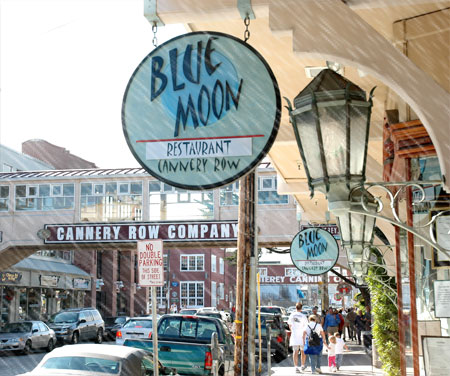 |
At left, the Blue Moon restaurant along Cannery Row is where we had dinner our first night in town. The back of the restaurant has tables facing the bay, where we were hypnotized by the blue waters while eating seafood dinners. "Cannery Row in Monterey in California is a poem, a stink, a grating noise, a quality of light, a tone, a habit, a nostalgia, a dream. Cannery Row is the gathered and scattered, tin and iron and rust and splintered wood, chipped pavement and weedy lots and junk heaps, sardine canneries of corrugated iron, honky tonks, restaurants and whore houses, and little crowded groceries, and laboratories and flophouses." —Cannery Row |
| Above, Cannery Row now, and at right the old Cannery Row, when it was a bustling fish packing center
"In the morning when the sardine fleet has made a catch, the purse-seiners waddle heavily into the bay blowing their whistles. The deep-laden boats pull in against the coast where the canneries dip their tails into the bay....Then cannery whistles scream and all over the town men and women scamble into their clothes and come running down to the Row to go to work. ... They come running to clean and cut and pack and cook and can the fish. The whole street rumbles and groans and rattles while the silver rivers of fish pour in out of the boats and the boats rise higher and higher in the water until they are empty. The canneries rumble and rattle and squeak until the last fish is cleaned and cut and cooked and canned and then the whistles scream again and the dripping, smelly, tired Wops and Chinamen and Polaks, men and women, straggle out and droop their ways up the hill into the town and Cannery Row becomes itself again—quiet and magical. —Cannery Row |
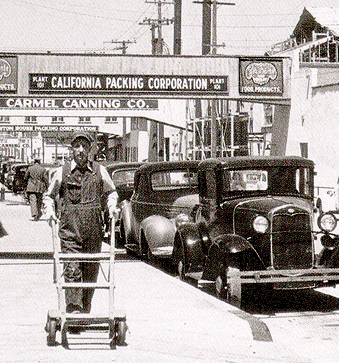 |
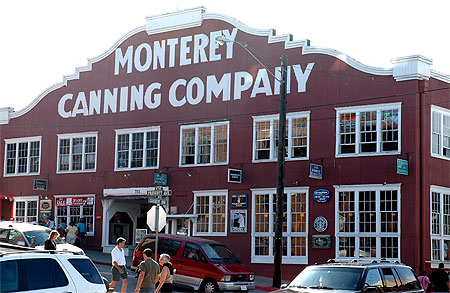 |
At left, one of the several old cannery buildings converted into shops, restaurants, bars, and museums.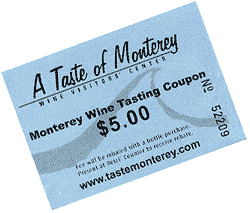 We found a wine tasting room (amazing, huh?) in one of the old canneries. The wines were mediocre, but the view, below, made sipping the wines a decidedly introspective and reflective experience. |
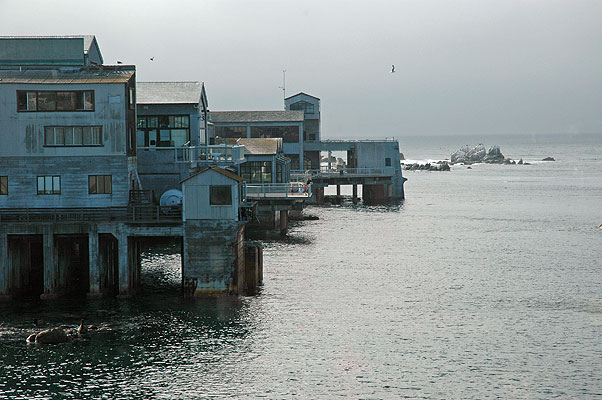 | ||
"Early morning is a time of magic in Cannery Row. In the gray time after the light has come and before the sun has risen, the Row seems to hang suspended out of time in a silvery light. The street lights go out, and the weeds are a brilliant green. The corrugated iron of the canneries glows with the pearly lucence of platinum or old pewter. ... And the rush and drag of the waves can be heard as they splash in among the piles of the canneries. It is a time of great peace, a deserted time, a little era of rest. Cats drip over the fences and slither like syrup over the ground to look for fish heads. ... The sea gulls come flapping in to sit on the cannery roofs to await the day of refuse. They sit on the roof peaks shoulder to shoulder. From the rocks near the Hopkins Marine Station comes the barking of sea lions like the baying of hounds." —Cannery Row |
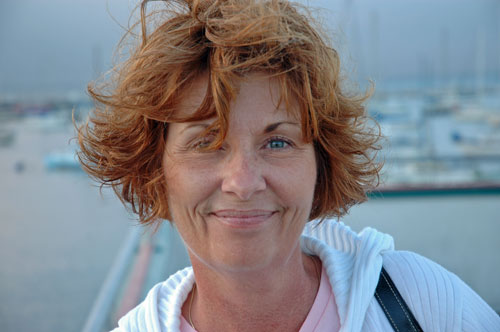 Cherie experienced a new sensation: fog hair. The humidity along the coast brought out curls she never knew she had. Her wild looks moved me to poetry of my own. |
| The Mermaid | ||||
|
Along the coast the winds caress, The waves embrace, then pull to depths The maidens of the land so fair Ne'er more to walk this earthen lair.
"Mermaids" the name the sailors gave |
And so, beware, ye men, of seas, Of siren songs among the keys, Let not your woman feel the breeze And walk too close to shore.
For she may fall upon the spell | |||
Her legs ajoined, her skin a-scaly, Her breath a hint of fish a-smelly Her hair a wreath of eels afraid— This woman now the sea's mer-maid | ||||
| See, I can be romantic, too! No wonder I get those looks when I ask Cherie to pose. For years I thought they were looks of longing. Now I understand they are looks of pity at a failed romantic poet. But hey, I'm sure all men are failures in the steely eyes of their beloved.
Anyway, on to the incredigull harbor views of Monterey. |
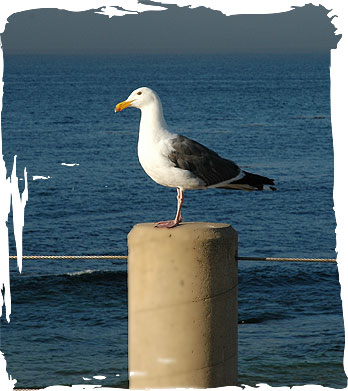 |
The Fog Rolls In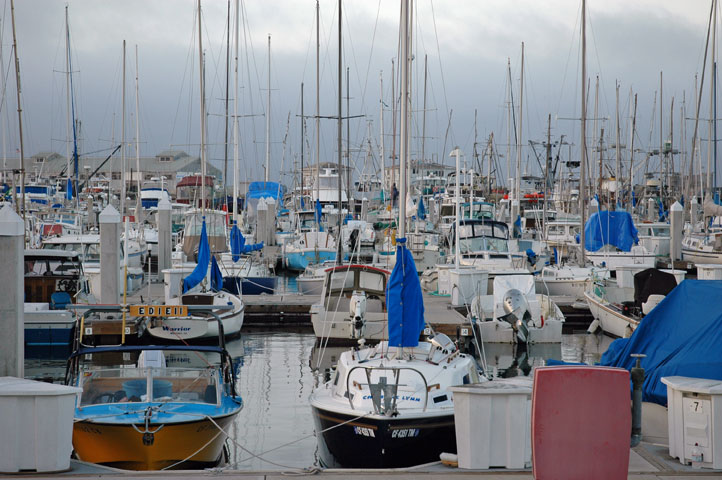 The fog begins to roll in to the harbor at evening, soon to enshroud the sailboats bobbing in the water near Fisherman's Wharf. The forest of masts and furled sails are a soothing sight for eyes used to arid desert terrain. |
| The berthed sailboats as seen from Fisherman's Wharf | 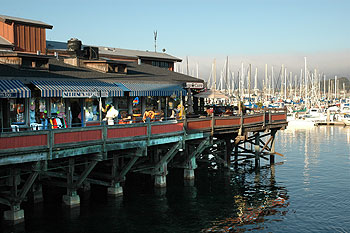 |
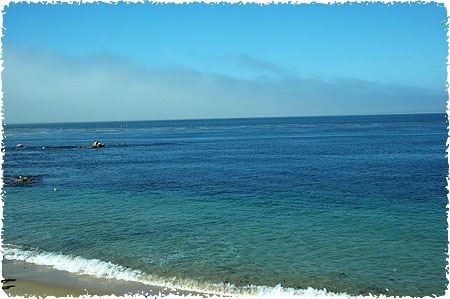 |
"Postcard" views from our table at the Blue Moon Restaurant, at left and below |
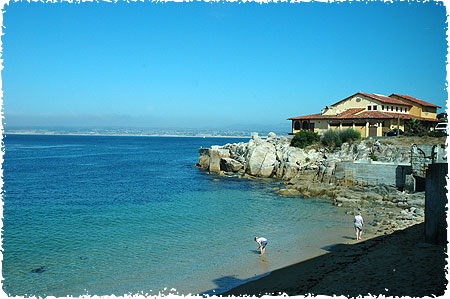 |
| Land's End The ocean is mesmerizing, and the tidal pools along the rocky coast are a universe like no other. John Steinbeck captured this universe and its mood in "Cannery Row" when he talked about his friend, "Doc," who collected sealife on the point, related below 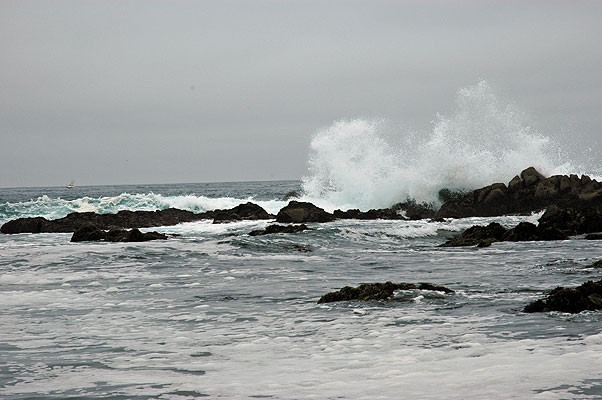
|
Doc was collecting marine animals in the Great Tide Pool on the tip of the Peninsula. It is a fabulous place: when the tide is in, a wave-churned basin, creamy with foam, whipped by the combers that roll in from the whistling buoy on the reef. But when the tide goes out the little water world becomes quiet and lovely. The sea is very clear and the bottom becomes fantastic with hurrying, fighting, feeding, breeding animals. Crabs rush from frond to frond of the waving algae. Starfish squat over mussels and limpets ... Orange and speckled and fluted nudibranchs slide gracefully over the rocks, their skirts waving like the dresses of Spanish dancers. ... The lovely, colored world is glassed over. ... A wave breaks over the barrier, and churns the glassy water for a moment and mixes bubbles into the pool, and then it clears and is tranquil and lovely and murderous again. ... The anemones expand like soft and brilliant flowers, inviting any tired and perplexed animal to lie for a moment in their arms ... On the exposed rocks out of water, the barnacles bubble behind their closed doors and the limpets dry out. And down to the rocks come the black flies to eat anything they can find. ... The smells of life and richness, of death and digestion, of decay and birth, burden the air. And salt spray blows in from the barrier where the ocean waits for its rising-tide strength to perit it back into the Great Tide Pool again. —Cannery Row 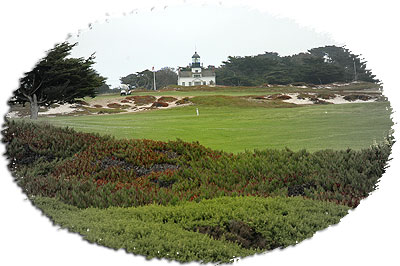 Historic Point Pinos Lighthouse, at the tip of Monterey Peninsula in Pacific Grove, was built in 1855 and is now nestled in a golf course that abuts the tidal pools on the coast. Cherie and I stopped here to walk among the barking seals and spy into the pools, looking for sealife and seashells |
| Monterey Bay Aquarium | 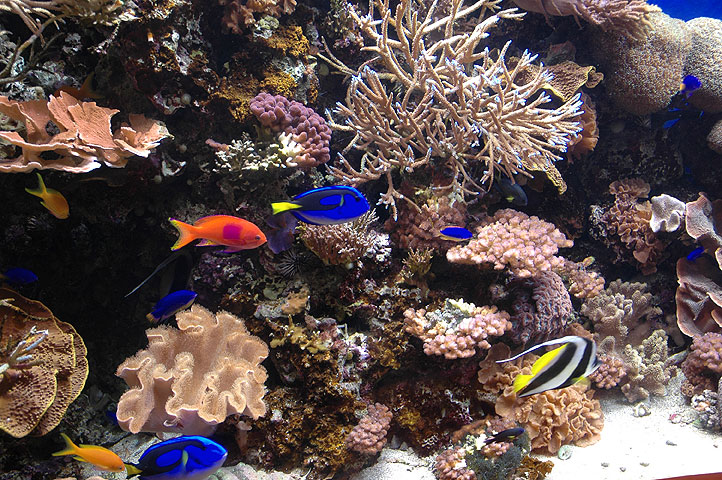 The aquarium at the end of Cannery Row offers views of the plant, avian and sea life in the Monterey Bay area, as well as other zones around the world.
The aquarium at the end of Cannery Row offers views of the plant, avian and sea life in the Monterey Bay area, as well as other zones around the world.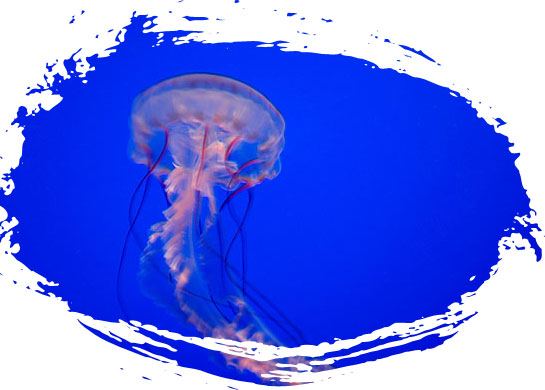 |
A jellyfish floats in the water like a colorfull storm cloud hanging in the evening sky. I had an encounter with a jellyfish decades ago (1976) when Mark and I drove down the New England coast and we stopped at a beach for a swim. I waded into the tendrils of a jellyfish, and the stinging burn lasted for a couple of hours. Watching them in tanks is by far the preferred method. The mammoth tanks in the aquarium house exotic and beautiful fish from from the deep. If you'd like to see more, the Monterey Bay Aquarium offers live web cams of serveral tanks from 7 a.m. to 7 p.m. Pacific Coast Time at the Monterey Bay Aquarium web site. |
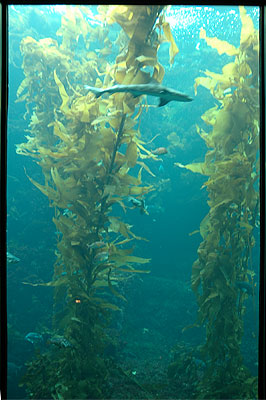
|
Return to the California Postcards Page 
 South to the Pacific Coast Highway
South to the Pacific Coast Highway
![]() — or —
— or —